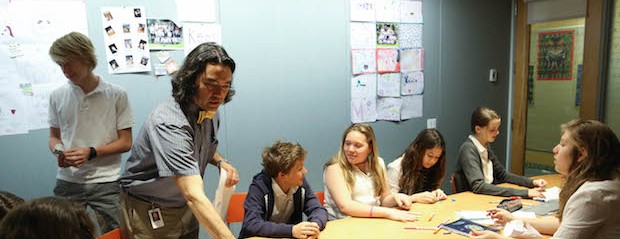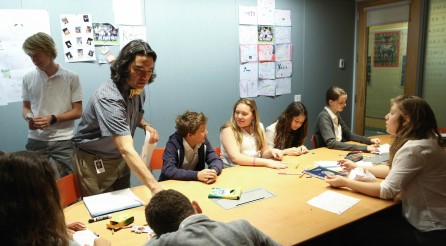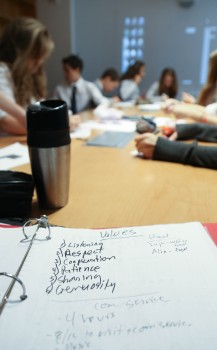The Analog Platform. That’s the phrase that came to my mind as I watched my twelve 5eme advisees. Some were writing and drawing on the wall-sized whiteboard of Student Resource Room A. Others were at the table drawing logos for our advisory that would decorate our room. Another student worked on homework. Many “platforms” going on, but one room. In this way, our classroom mirrors the way people use computers: multiple platforms are “on.” But since they are children, and I am their advisor, the situation is quite analog. One to one. But with a lot of “hits” in a short amount of time.
The students created art inspired from the Community Service hour they spent at a senior home.
This is my first year as an “official” advisor. Since I began at the Lycee in 2005, I have been an unofficial advisor and mentor, but now I am “official” for these twelve seventh graders. At the Lycee, it is the third year of this unique Franco-American style advisory – a support system designed to help Lycee students in their academic, emotional, and social lives at school. Each class is divided into two advisory groups, each with its own advisor. These groups meet for two ten-minute “check-in” during a week as well as one full period. In addition, each advisor attends a weekly meeting of his or her advisory group composed of other advisors and a grade coordinator. There is a curriculum for each grade related to issues relevant to each age group — diversity, social media, organizing and the like.
“At the core of advisory is student need”
So, for me, there is this idea of the analog platform for my advisory. But, I was curious to know how some of my fellow advisors see the work with their advisees. In a number of discussions, the notion that advisors are “advocates” for students arose. If a student is in academic need, the advisor often becomes the “point person” for coordinating information between teachers, parents, and the administration, to assure the student receives help they need and has the optimal kinds of environments for working and learning. If other needs arise, again, it is the advisor who navigates through issues, people, documents – with the goal being to provide the best help possible. At the core of advisory, is student need.
Secondary English Teacher Jiro Adachi with his 7th grade advisees.
For Sylvain Pappalardo, the “Jedi” coordinator of my advisory group of 5eme and 6eme advisors, “Meeting the expectations of teachers, parents, administrators, and students is the biggest challenge.”
My “binome” Benedicte Lemon, who also coordinates the 5eme advisory agrees. “The expectations are high,” she says, “and we have to fill many roles.”
In spite of this, all the advisors I spoke with agreed that the best part of advisory is their relationships with students. “They sometimes become like family,” says Mr. Pappalardo, “they trust you.”
No technology, no deadlines, no calendars: it’s about relationships
Indeed, in my advisory, I often feel like an uncle – having to balance humor with seriousness, generosity with discipline, fun with work. Mostly, I have felt the importance of trying to be a positive adult role model for these budding grown-ups. No small task. Moreover, in the process of writing this post, I realize that given the number of advisory-related activities and tasks going on in my school life — Analog Platform, c’est moi – to spin Flaubert’s quote about his character Madame Bovary. But this, in fact, is the thing I like best about the advisory system: It is driven by relationships – not technology, not deadlines, not calendars. The bonds and trust we establish with students, parents, teachers, the administration – these also seem to form part of the core of advisory.
Advisory values.
In fact, over the last weeks in my group, we have been watching bits of the highly entertaining sci-fi movie “The Core”. And, next week, I’ll prompt them to draw an answer to the question, “What is in your core?” which will refresh the decorations in our room. I can’t wait to see what they come up with. So, if you’re passing by Student Resource Room A, peek in and see for yourself.
About the Author :
Jiro Adachi has been teaching English at the Lycée since 2005. He is also the author of the novel The Island of Bicycle Dancers (St. Martin’s Press).




